We’re familiar with the close-up images of Earth captured by orbital satellites and astronauts on the International Space Station. But here are a few pictures of the Earth and Moon captured at a distance, while passing around the Moon, or orbiting distant Saturn. In the words of Carl Sagan, “Look again at that dot. That’s here. That’s home. That’s us. On it everyone you love, everyone you know, everyone you ever heard of, every human being who ever was, lived out their lives.”
Since Sagan commented on Voyager 1’s image of Earth, several more pics of the Earth and Moon have been captured that really put our tiny spot in the Universe into perspective.
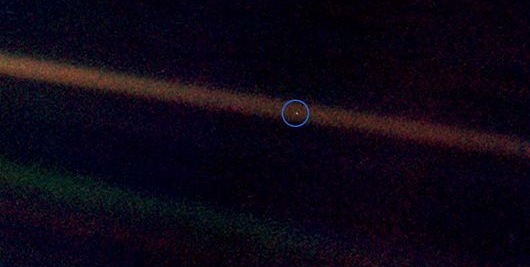
Voyager 1 – the Pale Blue Dot
This image, captured by NASA’s Voyager 1 spacecraft on February 14, 1990, is the one Sagan was talking about. It was taken when Voyager 1 was about 6.4 billion kilometres (4 billion miles) from Earth. In this image, the entirety of the planet takes up less than a single pixel; in fact, NASA calculated that we’re only 0.12 pixel in size. Sagan pushed the agency to capture images of all the planets in the Solar System, to create a family portrait seen from Voyager’s distant position.
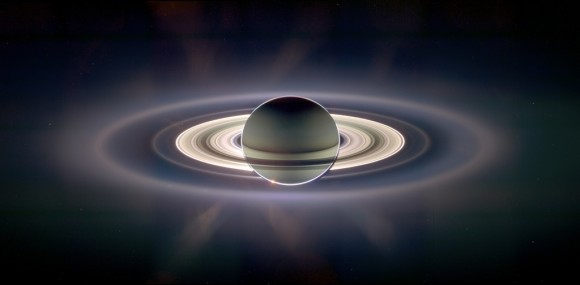
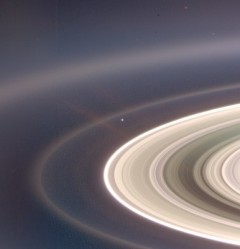
Cassini – the Earth from Saturn
This is easily the best picture ever captured by NASA’s Cassini spacecraft, and in the running for the best space pictures of all time. It shows Saturn in all its glory, backlit by the Sun. From this view, the rings glow with an ethereal light.
But this image is extra special. Take a look towards the upper left of the image, and you’ll notice a tiny blue-white dot. Once again, there’s Earth, seen from a distance of 1.4 billion km (1 billion miles).
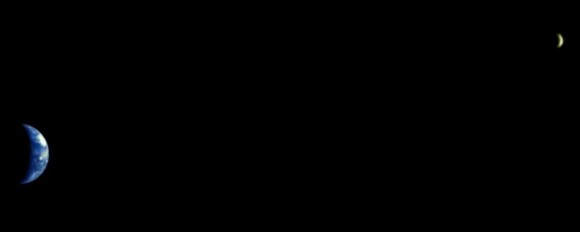
Mars Express – the Earth and Moon from Mars
ESA’s Mars Express captured this image of Earth and the Moon on July 3, 2005 when it was 8 million km (5 million miles). This was actually the first observational data sent back by the probe. A fitting introduction to Martian system. Of course, Mars Express was designed to image the relatively nearby surface of Mars, and not such distant objects, so the resolution of the image isn’t very good. And yet, they’re instantly recognizable as the Earth and Moon.
Opportunity Rover – the Earth from the Surface of Mars
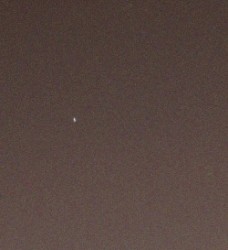 Here’s an image of Earth captured from the surface of another planet. In this case, we’re seeing Earth from Mars, as photographed by NASA’s Mars rover Opportunity on April 29, 2005. Normally operating only in the Martian day, Opportunity woke up a little after sunset, and captured this image of Earth as the stars were starting to come out. The image of Earth looks a little elongated because it was moving slightly during the 15-second exposures. Imagine what some future Martian might see, stepping out onto the surface of the Red Planet in the dusky twilight to see our bright planet in the sky.
Here’s an image of Earth captured from the surface of another planet. In this case, we’re seeing Earth from Mars, as photographed by NASA’s Mars rover Opportunity on April 29, 2005. Normally operating only in the Martian day, Opportunity woke up a little after sunset, and captured this image of Earth as the stars were starting to come out. The image of Earth looks a little elongated because it was moving slightly during the 15-second exposures. Imagine what some future Martian might see, stepping out onto the surface of the Red Planet in the dusky twilight to see our bright planet in the sky.
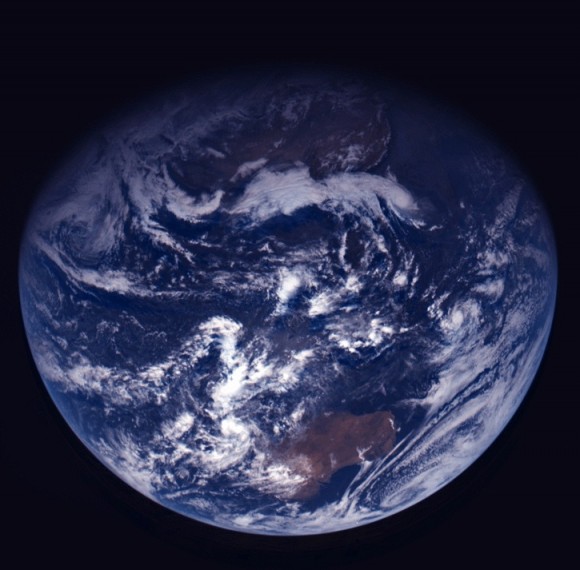
Rosetta – Earth and Moon during a flyby
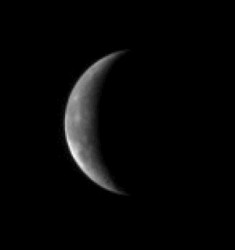
Now this is what you might have been expecting to see. A picture of Earth, with the continents clearly visible. This photograph of Earth and the other of the Moon were taken by ESA’s Rosetta spacecraft during a flyby on November 15, 2007. Rosetta’s primary mission is to visit Comet 67P/Churyumov-Gerasimenko in May 2014, but this flyby was a great opportunity for Rosetta to test out its OSIRIS camera system. The image of the Moon was taken separately.
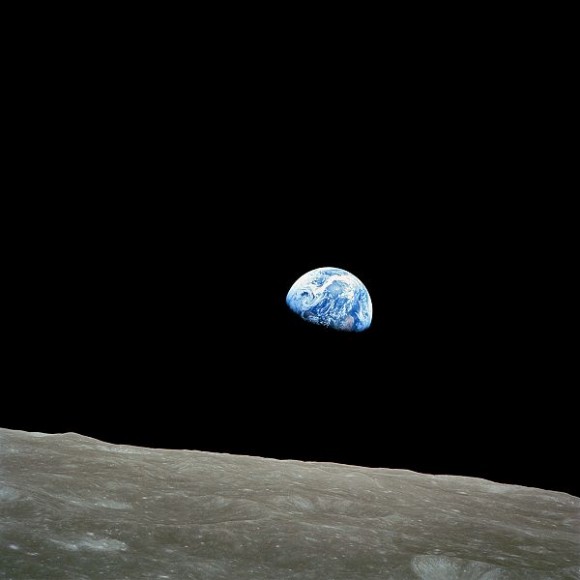
Earthrise – seen from the Moon
This is the classic “Earthrise” photograph, captured by astronaut William Anders during the historic Apollo 8 mission – the first human mission to the Moon. This photograph was taken on December 24, 1968. If you’re standing on the surface of the Moon, the Earth doesn’t actually “rise”. Since the Moon is tidally locked to the Earth, our planet always hangs in exactly the same point of the sky. It takes an orbiting spacecraft to see the Earth actually rise from the horizon.
This photograph was recreated by the Japanese Kaguya spacecraft, which captured a similar sequence of the Earth using its high-definition video camera.
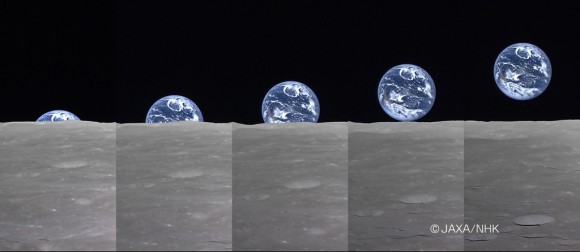
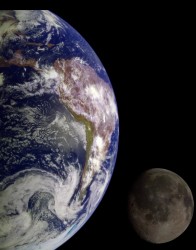 Earth from Galileo
Earth from Galileo
And finally, I think I’ve saved one of the best pictures for last. This is a photograph of the Earth and Moon (not to scale) captured by NASA’s Galileo spacecraft as it was speeding away towards Jupiter. Galileo captured these images in 1992, and finally reached the Jovian system in 1995-97. You’re looking at the Pacific Image, with South America visible as well as the Caribbean.

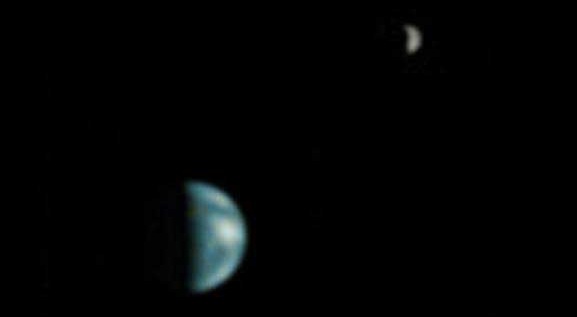
These are truly spectacular… I’ve never seen these all in one place!
Our political leaders should take a moment from time to time and contemplate these images. Especially the pixel-sized image of the Earth as a “mote of dust suspended in a sunbeam”, as Carl Sagan called it.
It puts our petty struggles in perspective and shows how fragile and irreplaceable the world is.
The Rosetta image of Earth needs to be flipped horizontally. That’s Australia in the picture.
that is totally NOT Australia. i can see Florida and Cuba.
If you’re standing on the surface of the Moon, the Earth doesn’t actually “rise”. Since the Moon is tidally locked to the Earth, our planet always hangs in exactly the same point of the sky. It takes an orbiting spacecraft to see the Earth actually rise from the horizon.
Actually, this is not true. The moon’s libration means that in some areas in the limit between the near side and the far side, the Earth does rise and set (in the same horizon… it goes back and forth) about once per month. And everywhere on the Moon, our planet only hangs in the same area of the sky, not the same spot.
That limit between the far and near sides would be a cute place to build a colony in, BTW.
amazing pics
Frazer:
Amazing photos. Just check the year when Rosetta will meet its target comet. It should say 2014.
Great job, nice to see all these photo’s together in one spot.
Great post – what a treat to see all these images lined up.
Estamos familiarizados con los primeros planos de la Tierra captados por satélites en órbita y los astronautas de la Estación Espacial Internacional. Pero a continuación les presentamos algunas imágenes de la Tierra y la Luna captadas a distancia, mientras las naves espaciales pasaban alrededor de la Luna o giraban alrededor de Saturno. En palabras de Carl Sagan: […] Fuente: Fraser Cain para Universe Today.
That totally IS Australia in the Rosetta image. Look at the Great Australian Bight. It does need flipping horizontally however as Dale said.
Great pictures. How about adding links to original higher resolution images?
You are trippin’ Greg That IS Australia. You can clearly see Eyre and Yorke peninsulas and as Aussie also said the Great Australian bight is clearly visable. The image does need to be flipped horizontally
Greg… look at a world map. What other continents look like that near Cuba and Florida? None. It is Australia. If you were seeing Cuba and Florida you would probably see parts of South America and/or the Gulf Coast of the U.S. There are no islands off the SE coast of the U.S. that are that big.
I don’t think the picture of Australia needs to be flipped. It is merely from an angle we are not used to seeing. Our brains have been trained to look at North to the top of the picture. I believe the land mass at the top of the photo is actually the South Pole during the South Pole’s summer (again we are trained to think of it as nothing but ice/snow but at certain times of the year, land is visible). I can’t see it well enough to know for sure.
I tried to put a Google Earth layout next to the photo of Australia and in one sense, it does look like Australia needs to be flipped over. But then that would make Asia’s land mass wrong. And if the land mass at the top of the photo is Asia, why can’t we see any of the many islands between Australia and Asia? But there is a large mass of ocean between Australia and the south pole. The cloud cover makes it hard to see what angle the picture is from and whether it was developed upside down or inside out but I have to agree that Australia doesn’t quite look like it should.
The Cassini picture of Earth From Saturn is really awesome. It will be my desktop for quite some time for sure!
The “earthrise” original pic was not horizontal as is commonly depicted. The original photograph is a vertical photograph, i.e., the earth is on the left and the moon on the right. It has been published many times over in the incorrect format to fit the description.
The photograph was taken as the astronauts rounded the surface from the dark side… so it was never really an earth rise but rather the earth coming back into view.
Wonderful photos thanks for posting.
My vision isnt what it used to be. I cant seem to spot the earth in the Cassini picture from Saturn. I see a whitish object in the very outer ring and more in the center of the picture. I doubt if thats Earth but if it isnt could some kind person be more specific as to its location
Thanks
Of course it is Australia in the Rosetta picture of Earth.
If in the upper center it were South America, then where is Anctartica and the South Pole. Did it melt away already?
Brilliant pictures
(and yes, it IS Australia…………………….)
It is Australia. Try checking the ESA image here flipped horizontally against an image on the http://www.sat.dundee.ac.uk archive for geostationary satillites for November 15th 0300UTC hrs in visible light. On that image the cloud formations are very closely matched but as the angle is different more of the other continents are in view.
hey youre all totally right. It is Australia. Although I was not tripping…I was looking at the last photo of the earth/moon,from Galileo.
We are so used to a North South orientation that we automatically see the Earth as slightly tilted in the picture, but of course it really is. Fact is if you lived all your life in a culture with a South North way of thinking, you might say the picture is upside down. This ol Earth looks wonderful from space at any angle in my opinion. I also appreciate that explanation of the rising Earth cause it don’t move across the sky like the moon does as seen from here and it’s one of the hard concepts for my students to understand. Everything we know is relative to the Earth.
To be fair, its a simple concept its just a wee bit alien.
hye guys, nevermind about what i said earlier. It is defenitley NOT Australia no matter what you have to say. And thats my final answer.
Absolutely marvelous photography. However, the Universe seems to be a lonely place without life to acknowledge its splendor!
Those photographs are awesome! The more of such a person sees the less attached to things he should become. This life is sure more than bricks and sticks.
I love these photos !!!!They are awesome !!! I can’t wait to look at more !!!!
here’s a way to decide whether or not it’s australia: look at a map. yes, some of those islands look like indonesia, but they look a lot more like jamaica and the dominican republic/haiti. just saying.
-m
THESE ARE SOOOOOOOOOOOO KEWL!!!!!!!!!!!!!!!!!!!!!!!1
very good site thank you
fuck to all of you
Why can’t i find any real close up pics of the moon. I mean if we were walking on the moon which i doubt then why dont we have any good pics of it